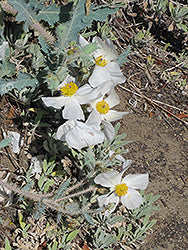Romneya coulteri (Coulter's Matilija Poppy)
Volume discounts calculated in cart.
| Subtotal | ||
|---|---|---|
|
Log In to View Prices | |
| Log In to View Prices | ||
Loading...
A Californian native perennial featuring volumes of large, showy white blooms with golden centers over glaucous gray foliage; peak flowering during spring and summer; spreads by underground runners, establish a root barrier if containment is desired
Coulter's Matilija Poppy is a spreading perennial with an upright spreading habit of growth. Its medium texture blends into the garden, but can always be balanced by a couple of finer or coarser plants for an effective composition.
This plant will require occasional maintenance and upkeep, and should be cut back in late fall in preparation for winter. It is a good choice for attracting birds, bees and butterflies to your yard, but is not particularly attractive to deer who tend to leave it alone in favor of tastier treats. Gardeners should be aware of the following characteristic(s) that may warrant special consideration;
Coulter's Matilija Poppy has masses of beautiful fragrant white cup-shaped flowers with gold centers at the ends of the stems from early spring to mid summer, which are most effective when planted in groupings. The flowers are excellent for cutting. Its attractive tomentose lobed pinnately compound leaves emerge light green in spring, turning powder blue in colour with showy grayish green variegation throughout the season.
Coulter's Matilija Poppy will grow to be about 3 feet tall at maturity extending to 5 feet tall with the flowers, with a spread of 8 feet. It grows at a fast rate, and under ideal conditions can be expected to live for approximately 20 years. As an herbaceous perennial, this plant will usually die back to the crown each winter, and will regrow from the base each spring. Be careful not to disturb the crown in late winter when it may not be readily seen!
Coulter's Matilija Poppy is a fine choice for the garden, but it is also a good selection for planting in outdoor pots and containers. With its upright habit of growth, it is best suited for use as a 'thriller' in the 'spiller-thriller-filler' container combination; plant it near the center of the pot, surrounded by smaller plants and those that spill over the edges. It is even sizeable enough that it can be grown alone in a suitable container. Note that when growing plants in outdoor containers and baskets, they may require more frequent waterings than they would in the yard or garden.
Details
Botanical Name
Romneya coulteri
Common Name
Coulter's Matilija Poppy
Hardiness Zone
- 8
Appearance
Max Height
3 Feet (5 Feet With The Flowers)
Max Spread
8 Feet
Plant Form
- Upright Spreading
Foliage Colour
- Blue
Fall Colour
Flower Colour
- White
Edible
Edible Component
Edible Harvest Period
Edible Use
Fruit Colour
Growing
Flowering Period
From Early Spring To Mid Summer
Moisture
Dry To Average
Sunlight
Partial Shade
Maintenance
Medium
Deer Resistance
Yes
Your cart

Romneya coulteri (Coulter's Matilija Poppy)
A Californian native perennial featuring volumes of large, showy white blooms with golden centers over glaucous gray foliage; peak flowering during spring and summer; spreads by underground runners, establish a root barrier if containment is desired
Coulter's Matilija Poppy is a spreading perennial with an upright spreading habit of growth. Its medium texture blends into the garden, but can always be balanced by a couple of finer or coarser plants for an effective composition.
This plant will require occasional maintenance and upkeep, and should be cut back in late fall in preparation for winter. It is a good choice for attracting birds, bees and butterflies to your yard, but is not particularly attractive to deer who tend to leave it alone in favor of tastier treats. Gardeners should be aware of the following characteristic(s) that may warrant special consideration;
Coulter's Matilija Poppy has masses of beautiful fragrant white cup-shaped flowers with gold centers at the ends of the stems from early spring to mid summer, which are most effective when planted in groupings. The flowers are excellent for cutting. Its attractive tomentose lobed pinnately compound leaves emerge light green in spring, turning powder blue in colour with showy grayish green variegation throughout the season.
Coulter's Matilija Poppy will grow to be about 3 feet tall at maturity extending to 5 feet tall with the flowers, with a spread of 8 feet. It grows at a fast rate, and under ideal conditions can be expected to live for approximately 20 years. As an herbaceous perennial, this plant will usually die back to the crown each winter, and will regrow from the base each spring. Be careful not to disturb the crown in late winter when it may not be readily seen!
Coulter's Matilija Poppy is a fine choice for the garden, but it is also a good selection for planting in outdoor pots and containers. With its upright habit of growth, it is best suited for use as a 'thriller' in the 'spiller-thriller-filler' container combination; plant it near the center of the pot, surrounded by smaller plants and those that spill over the edges. It is even sizeable enough that it can be grown alone in a suitable container. Note that when growing plants in outdoor containers and baskets, they may require more frequent waterings than they would in the yard or garden.
Are you a wholesale customer?
The Green Thumb Nurseries website is for wholesale customers only. If you're looking for the retail Garden Centre, we have a separate site for your shopping needs!
-
Customer Care
(250) 758-0808 ext. 2
sales@greenthumbwholesale.com -
Visit Us
6261 Hammond Bay Rd
Nanaimo, BC V9T 5M4 -
Wholesale Nursery Hours
Mon - Fri 8:00AM - 4:30PM
Not open to the public, Check in at the Office When Visiting -
Retail Garden Centre Hours
Every Day
9:00AM - 5:00PM

